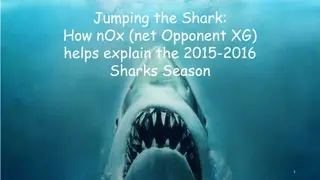The Unique Digestive System and Respiratory Adaptations of Sharks
Sharks have a distinct digestive system with little physical digestion in the mouth, strong stomach acids in their U-shaped stomachs, and a spiral valve in the intestines. Their respiratory system involves gills that extract oxygen from water through ram jet ventilation. Understanding these specialized adaptations gives insight into the biology and behavior of sharks.
Download Presentation

Please find below an Image/Link to download the presentation.
The content on the website is provided AS IS for your information and personal use only. It may not be sold, licensed, or shared on other websites without obtaining consent from the author.If you encounter any issues during the download, it is possible that the publisher has removed the file from their server.
You are allowed to download the files provided on this website for personal or commercial use, subject to the condition that they are used lawfully. All files are the property of their respective owners.
The content on the website is provided AS IS for your information and personal use only. It may not be sold, licensed, or shared on other websites without obtaining consent from the author.
E N D
Presentation Transcript
Dr.M.DEIVANAYAKI DEPT OF ZOOLOGY ALLIED CHE&BOT
Digestion in the mouth Little physical digestion occurs in the mouth as most sharks swallow their food whole or in very large pieces. Food goes down the short and wide esophagus; most of the time it is hard to distinguish from the stomach. This is unlike the human digestion in the mouth, as humans do a lot of physical digestion by chewing their food.
Digestion In the stomach Sharks have U-shaped stomachs that use very strong stomach acids and enzymes to dissolve most of what is eaten. The digestion in the stomach is also different from humans because of the differentiation in diet. Our system does not require as strong stomach acids and enzymes because we eat lighter foods than sharks. Stomach contents that cannot be digested, such as very large bones, are vomited. 3. Digestion in the Intestine The stomach leads to the intestines which in sharks, is referred to as the spiral valve. The intestines are short but have a large surface area due to the infolding of the inner surface, some are arranged in folds, and some are in a spiral pattern. The digestive tract leads to the rectum and to the cloaca. The cloaca is a common opening for the urinary, digestive, and reproductive systems. Human intestines contain villi and microvilli, just like the spiral valves are arranged in folds or spirals to increase surface area and nutrient absorption. Both digestive tracts also contain a rectum however humans have an anus instead of a cloaca.
Like other fish, sharks "breathe" through their gills, which are respiratory organs akin to our lungs. As water passes over the gill's membranes, tiny blood vessels extract oxygen from the water. Carbon dioxide waste also passes from the shark's blood and out of its body through the gill tissue
In order to respire, sharks must utilize ram jet ventilation, which consists of forcing water into their mouths, throats, and eventually out of their gill slits
Sharks use their gills to absorb oxygen from the water. Most sharks have five gill slits on each side of their body, behind the mouth and above the pectoral fins. Water enters the mouth of the shark, enters a canal between the mouth and the gills (the orobranchial cavity), and then passes back to the outside through the gill openings. As the water passes over the gills, oxygen is absorbed into the blood across the thin skin of the gill surface, and carbon dioxide moves into the water.
Water can flow across the gills by two mechanisms. First, as the shark is swimming it may hold its mouth open, allowing water to flow in and then out through the gill slits as the fish moves forward. Some sharks, however, can get enough oxygen when they are not swimming by gulping water into their mouth, then forcing the water out through the gills with muscular contractions of the orobranchial cavity. It is not true that all sharks must always keep swimming to breathe.
Circulatory And Respiratory System Circulatory System A shark s heart is a two-chambered S-shaped tube, small in proportion to body size located in the head region. Has an atrium and ventricle. The blood is pumped by the heart through the afferent branchial arteries to capillaries in the gills, where the blood is oxygenated). The blood then flows through efferent branchial arteries, through the tissues of the body, and back to the heart in veins. Sharks have low blood pressures; the walls of the pericardium are rigid, creating suction within the pericardium to maintain the flow of blood. To circulate blood throughout their bodies, many sharks must swim continuously. The blood flow is similar to humans because blood is pumped by the heart to the rest of the body by arteries and returned to the heart by veins. A difference is that humans have 4-chambered hearts while sharks only have 2 chambers. Humans also don t need to constantly move to circulate their blood, as we have higher blood pressures and we can maintain our body temperatures with food energy. Humans are warm blooded creatures, while most sharks are cold blooded which requires them to constantly move and use external heat sources to maintain body temperature.























